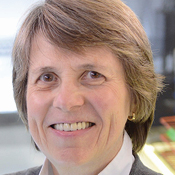
For her leading role in the discovery of Prochlorococcus, a marine microorganism that is the most abundant photosynthetic organism known, and for her pioneering studies exploring the role of Prochlorococcus and other ocean microbes in global chemical cycles and Earth’s climate.
Through her studies of Prochlorococcus cyanobacteria, Sallie “Penny” Chisholm's research of the smallest and most abundant photosynthetic cell on the planet has changed the way we think about how ocean ecosystems work. Her work as an educator and environmental advocate has complemented her scientific contributions by increasing public awareness and appreciation for the intricacy and interdependence of all life on our planet.
Some of the most important lifeforms on Earth are never seen or encountered by most humans, yet without them, practically all life on Earth would be impossible. These lifeforms are phytoplankton, microscopic organisms living in all of Earth’s lakes, streams, and oceans, producing half of all atmospheric oxygen through photosynthesis. Understanding phytoplankton is not just a matter of scientific interest but key to the continued survival of life, even as these precious organisms are impacted by human activities. One of the most important single members of the vast array of phytoplankton varieties is a cyanobacterial genus called Prochlorococcus. Sallie “Penny” Chisholm played a leading role in the discovery of Prochlorococcus and has dedicated her career to studying it and the role of marine microorganisms in maintaining the ocean ecosystem.
Not only do phytoplankton carry out about half of all the photosynthesis on Earth, they feed all life in the sea. It is only in about the last century that we have come to appreciate the role they play in the global cycling of carbon dioxide. Up until the mid-1970s, it was thought that the smallest phytoplankton were about 1/10th the width of a human hair. But there were hints that scientists were missing something—that there could be much smaller cells out there, and that they might be very abundant. Those phytoplankton were just too small to see, even with the most powerful microscopes of the time. In 1979, the introduction of fluorescent microscopy to oceanography revealed some ubiquitous, small, and abundant cyanobacteria in the sea—Synechococcus—which expanded the size distribution of phytoplankton in seawater. But that was just the beginning of a new chapter.
In 1987, Chisholm and her colleagues acquired an instrument used in medical research to study cancer cells—a flow cytometer, which allows one to measure properties of individual cells as they pass one-by-one through a laser beam. The research team put it on a ship, and set off to the Sargasso Sea. When they pumped seawater through it, they observed very tiny cells with properties that showed that they contained chlorophyll, the pigment plants use in photosynthesis. After comparing their data with observations by other researchers and collecting samples in other areas, they identified Prochlorococcus for the first time, publishing their results in Nature in 1988. Further research showed that Prochlorococcus is smaller and even more abundant than Synechococcus, making it the smallest and most abundant photosynthetic cell on the planet. Later, Chisholm's genomic studies showed it to be one of the most genetically diverse types of phytoplankton, allowing it to survive and thrive in a broad range of marine environments, one factor contributing to its prevalence and centrality in the oceanic carbon cycle and the global ecosystem. Through studying Prochlorococcus from its genome to the global oceans, Chisholm showed that to understand what shapes our living planet, we need to study life at all scales. In doing so, we learn that each species has a lot to teach us about how living systems have evolved and shape our world today.
Born and raised in the Upper Peninsula of Michigan, Chisholm spent her childhood exploring the outdoors on Lake Superior. She earned her undergraduate degree from Skidmore College in 1969 and her doctorate from SUNY Albany in 1974. After a post-doctoral fellowship at Scripps Institution of Oceanography, she has spent her entire career at MIT, while also working as a visiting researcher at the nearby Woods Hole Oceanographic Institution. Yet Chisholm's influence ranges far beyond her own field and the generations of students she has trained, many of whom have gone on to their own distinguished careers in oceanography, biology, and related disciplines.
As the effects of climate change become increasingly clear and damaging, the significance of preserving and protecting our oceans and the varieties of life they harbor has assumed ever-greater public visibility as well as inclusion in debates on political and social policy. Chisholm is a prominent voice in the public forum on climate change issues, in particular the risks of proposed ocean geoengineering, serving as a tireless spokesperson for and defender of the Earth's oceans. Throughout her career, she has also been dedicated to public education and outreach, helping people to understand and share her deep respect for the seas and oceans of our planet and the critical need to uncover their mysteries and to protect them. These efforts extend to even the youngest stewards of our planet. Chisholm has authored a series of children’s books—the "Sunlight Series"—which explain how the Sun and photosynthesis support life on Earth, the importance of our oceans, and the history of fossil fuel and how it impacts Earth’s climate.
Through her research, her teaching and mentorship, and her example as a scholar and scientist, Penny Chisholm has spent an entire career dedicated to advancing and expanding the boundaries of her own field, playing an indispensable role in creating a more profound understanding and appreciation for the intricately woven web of life on Earth.

